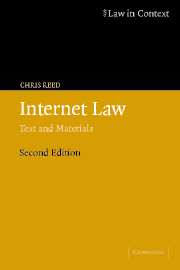Book contents
- Frontmatter
- Contents
- Preface
- Table of UK Statues
- Table of statutes–foreign jurisdictions
- Table of European Communities legislation
- Table of Conventions and Agreements
- Table of cases
- Introduction
- 1 The Internet as a distributed environment
- 2 From each according to his ability : actors and activities in the Internet world
- 3 An infinity of scarce resources : ownership and use of Internet resources
- 4 New actors on a new stage : intermediary liability in the Internet world
- 5 On the Internet, nobody knows you're a dog: identity and identification
- 6 Old wine in new bottles : traditional transactions in the Internet environment
- 7 The long arm of the law : cross-border law and jurisdiction
- 8 Legislative and regulatory arbitrage
- 9 Enforceability in the Internet environment
- 10 Facing the legislative and regulatory challenge
- Index
7 - The long arm of the law : cross-border law and jurisdiction
Published online by Cambridge University Press: 05 June 2012
- Frontmatter
- Contents
- Preface
- Table of UK Statues
- Table of statutes–foreign jurisdictions
- Table of European Communities legislation
- Table of Conventions and Agreements
- Table of cases
- Introduction
- 1 The Internet as a distributed environment
- 2 From each according to his ability : actors and activities in the Internet world
- 3 An infinity of scarce resources : ownership and use of Internet resources
- 4 New actors on a new stage : intermediary liability in the Internet world
- 5 On the Internet, nobody knows you're a dog: identity and identification
- 6 Old wine in new bottles : traditional transactions in the Internet environment
- 7 The long arm of the law : cross-border law and jurisdiction
- 8 Legislative and regulatory arbitrage
- 9 Enforceability in the Internet environment
- 10 Facing the legislative and regulatory challenge
- Index
Summary
It is a general principle in the physical world that the laws of a particular jurisdiction normally only have effect within the boundaries of that jurisdiction. The application of this principle to physical world activities is comparatively straightforward; the geographical location of an actor or an object at the relevant time is objectively determinable, and on that basis the application of local law and the appropriate jurisdiction can be decided.
The geography of the Internet, however, is purely virtual. In operation it pays no heed to geographical or political boundaries. Furthermore, the physical world location of those parts of the Internet infrastructure via which a communication is carried may be purely fortuitous. The result in many cases is that the parties to an Internet transaction are faced with overlapping and often contradictory claims that national law applies to some part of their activities. In the physical world such overlaps are comparatively rare and, except in private law actions, are often ignored as being too trivial to require legal action. In the Internet world these overlaps are pervasive, and have the potential to stifle legitimate activity or even to encourage deliberate law-breaking.
- Type
- Chapter
- Information
- Internet LawText and Materials, pp. 217 - 268Publisher: Cambridge University PressPrint publication year: 2004

